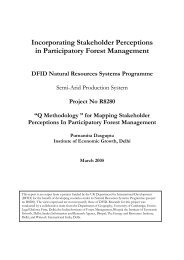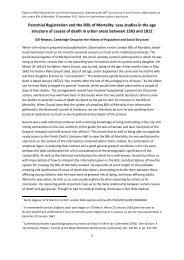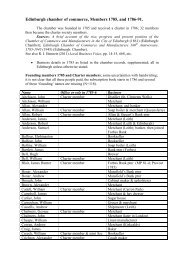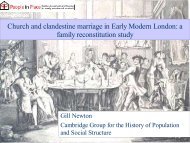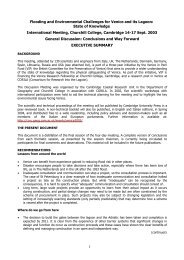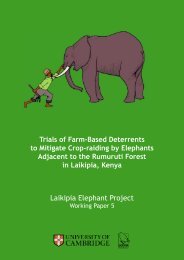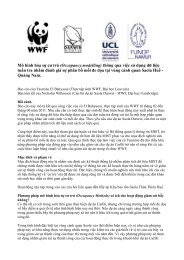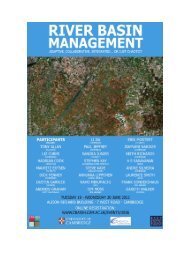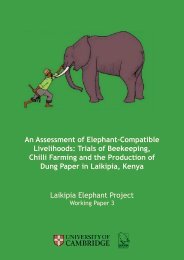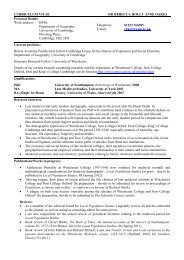Rob Small's Masters Thesis: Uptake and the success of insect ...
Rob Small's Masters Thesis: Uptake and the success of insect ...
Rob Small's Masters Thesis: Uptake and the success of insect ...
Create successful ePaper yourself
Turn your PDF publications into a flip-book with our unique Google optimized e-Paper software.
Chapter 1<br />
Post Independent Papua New Guinea<br />
Colonial History<br />
The isl<strong>and</strong> <strong>of</strong> New Guinea is believed to have been populated for <strong>the</strong> past 50000 years with<br />
<strong>the</strong> isl<strong>and</strong>s first settlers coming from South East Asia. The first Europeans to discover this<br />
vast isl<strong>and</strong> were <strong>the</strong> Portuguese. In 1526 it was named Ilhas dos Papuas (Isl<strong>and</strong> <strong>of</strong> <strong>the</strong><br />
Fuzzy Haired People) by Jorge de Meneses. Subsequently ano<strong>the</strong>r Portuguese named <strong>the</strong><br />
isl<strong>and</strong> New Guinea in 1545 as he thought that <strong>the</strong> coastline was reminiscent <strong>of</strong> Equatorial<br />
Guinea in West Africa. These dates mark <strong>the</strong> first <strong>of</strong>ficial recognition <strong>of</strong> <strong>the</strong> isl<strong>and</strong> by <strong>the</strong><br />
West but products originating from New Guinea had been items <strong>of</strong> trade for several<br />
hundred years before <strong>the</strong> Portuguese discovery. The main items <strong>of</strong> trade were plumes from<br />
<strong>the</strong> isl<strong>and</strong>’s remarkable Birds <strong>of</strong> Paradise. Plumes have been found as far as Persia dating<br />
back to <strong>the</strong> 16 th century. The trade in plumes occurred alongside an increasing dem<strong>and</strong> for<br />
spices (mace, cinnamon <strong>and</strong> nutmeg) that originated from <strong>the</strong> Moluccan Isl<strong>and</strong>s to <strong>the</strong> west<br />
<strong>of</strong> mainl<strong>and</strong> New Guinea. The European market for <strong>the</strong>se spices led to <strong>the</strong> establishment <strong>of</strong><br />
a Dutch colony on <strong>the</strong> Moluccan Isl<strong>and</strong>s. Initial trips to mainl<strong>and</strong> New Guinea from this<br />
colony revealed no evidence <strong>of</strong> spices to be found <strong>and</strong> <strong>the</strong> interest <strong>of</strong> <strong>the</strong> colonial powers<br />
extending <strong>the</strong>ir influence onto <strong>the</strong> mainl<strong>and</strong> subsided. However, although <strong>the</strong> Dutch had no<br />
economic interest in mainl<strong>and</strong> New Guinea at that time <strong>the</strong>y did annex <strong>the</strong> isl<strong>and</strong> up to <strong>the</strong><br />
140 parallel. This territory was administrated by <strong>the</strong> Sultans from <strong>the</strong> Moluccan Isl<strong>and</strong>s.<br />
During <strong>the</strong> 18 th century several expeditions were made by <strong>the</strong> French <strong>and</strong> British to chart<br />
<strong>the</strong> coast <strong>of</strong> New Guinea <strong>and</strong> to extend colonial influence over this region. Yet it wasn’t<br />
until <strong>the</strong> late 19 th century that <strong>the</strong> Eastern half <strong>of</strong> <strong>the</strong> isl<strong>and</strong> was annexed by colonial<br />
13




